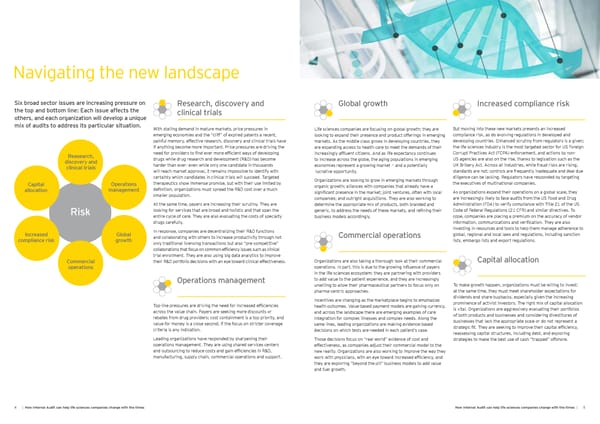Navigating the new landscape Six broad sector issues are increasing pressure on Research, discovery and Global growth Increased compliance risk the top and bottom line: Each issue affects the clinical trials others, and each organization will develop a unique mix of audits to address its particular situation. With stalling demand in mature markets, price pressures in Life sciences companies are focusing on global growth: they are But moving into these new markets presents an increased emerging economies and the “cliff” of expired patents a recent, looking to expand their presence and product offerings in emerging compliance risk, as do evolving regulations in developed and painful memory, effective research, discovery and clinical trials have markets. As the middle class grows in developing countries, they developing countries. Enhanced scrutiny from regulators is a given; if anything become more important. Price pressures are driving the are expanding access to health care to meet the demands of their the life sciences industry is the most targeted sector for US Foreign Reasearch, need for providers to find ever more efficient ways of developing increasingly affluent citizens. And as life expectancy continues Corrupt Practices Act (FCPA) enforcement, and actions by non- discovery and drugs while drug research and development (R&D) has become to increase across the globe, the aging populations in emerging US agencies are also on the rise, thanks to legislation such as the clinical trials harder than ever: even while only one candidate in thousands economies represent a growing market — and a potentially UK Bribery Act. Across all industries, while fraud risks are rising, will reach market approval, it remains impossible to identify with lucrative opportunity. standards are not; controls are frequently inadequate and deal due certainty which candidates in clinical trials will succeed. Targeted Organizations are looking to grow in emerging markets through diligence can be lacking. Regulators have responded by targeting Capital Operations therapeutics show immense promise, but with their use limited by organic growth; alliances with companies that already have a the executives of multinational companies. allocation management definition, organizations must spread the R&D cost over a much significant presence in the market; joint ventures, often with local As organizations expand their operations on a global scale, they smaller population. companies; and outright acquisitions. They are also working to are increasingly likely to face audits from the US Food and Drug At the same time, payers are increasing their scrutiny. They are determine the appropriate mix of products, both branded and Administration (FDA) to verify compliance with Title 21 of the US Risk looking for services that are broad and holistic and that span the generic, to address the needs of these markets, and refining their Code of Federal Regulations (21 CFR) and similar directives. To entire cycle of care. They are also evaluating the costs of specialty business models accordingly. cope, companies are placing a premium on the accuracy of vendor drugs carefully. information, communications and verification. They are also In response, companies are decentralizing their R&D functions investing in resources and tools to help them manage adherence to Increased Global and collaborating with others to increase productivity through not Commercial operations global, regional and local laws and regulations, including sanction compliance risk growth only traditional licensing transactions but also “pre-competitive” lists, embargo lists and export regulations. collaborations that focus on common efficiency issues such as clinical trial enrollment. They are also using big data analytics to improve Capital allocation Commercial their R&D portfolio decisions with an eye toward clinical effectiveness. Organizations are also taking a thorough look at their commercial operations operations. In part, this is due to the growing influence of payers in the life sciences ecosystem: they are partnering with providers Operations management to add value to the patient experience, and they are increasingly unwilling to allow their pharmaceutical partners to focus only on To make growth happen, organizations must be willing to invest; pharma-centric approaches. at the same time, they must meet shareholder expectations for Incentives are changing as the marketplace begins to emphasize dividends and share buybacks, especially given the increasing Top-line pressures are driving the need for increased efficiencies health outcomes. Value-based payment models are gaining currency, prominence of activist investors. The right mix of capital allocation across the value chain. Payers are seeking more discounts or and across the landscape there are emerging examples of care is vital. Organizations are aggressively evaluating their portfolios rebates from drug providers; cost containment is a top priority, and integration for complex illnesses and complex needs. Along the of both products and businesses and considering divestitures of value for money is a close second, if the focus on stricter coverage same lines, leading organizations are making evidence-based businesses that lack the appropriate scale or do not represent a criteria is any indication. decisions on which tests are needed in each patient’s case. strategic fit. They are seeking to improve their capital efficiency, reassessing capital structures, including debt, and exploring Leading organizations have responded by sharpening their Those decisions focus on “real world” evidence of cost and strategies to make the best use of cash “trapped” offshore. operations management. They are using shared services centers effectiveness, as companies adjust their commercial model to the and outsourcing to reduce costs and gain efficiencies in R&D, new reality. Organizations are also working to improve the way they manufacturing, supply chain, commercial operations and support. work with physicians, with an eye toward increased efficiency, and they are exploring “beyond the pill” business models to add value and fuel growth. 4 | How Internal Audit can help life sciences companies change with the times How Internal Audit can help life sciences companies change with the times | 5
 Are you Ready for the Empowered Consumer? Page 3 Page 5
Are you Ready for the Empowered Consumer? Page 3 Page 5